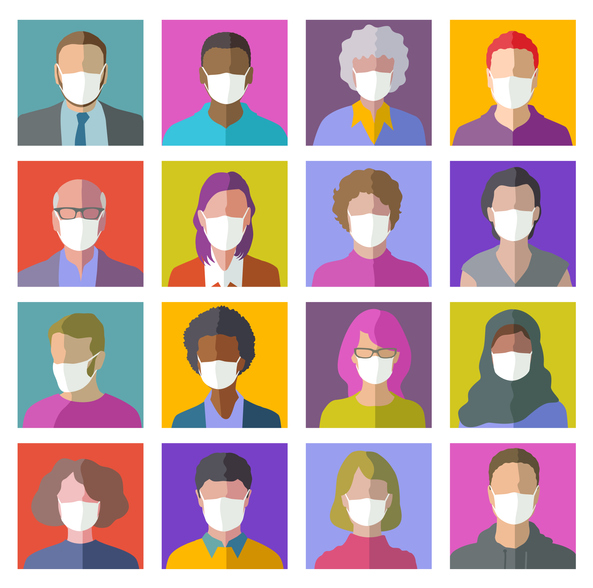Surging COVID-19 rates throughout the country and in many parts of the world make our efforts to protect ourselves and others more important than ever. Yes, the predictions are dire, but we are not helpless. Experts estimate we can save hundreds of thousands of lives and considerably boost the chances of controlling the pandemic if we all commit to wearing a mask and follow familiar preventive measures: maintain physical distance; wash hands frequently; avoid others if you’re sick; and isolate yourself and get tested if you have close contact with someone who has the disease.
So, why do we believe masks work?
Early in the pandemic, experts expressed skepticism that masks would be helpful for the general public, particularly in places with little to no community spread of the virus. In addition, to avoid worsening shortages of medical-grade masks for health workers who needed this protection, masks were not widely recommended.
But we’ve seen a rapidly expanding body of evidence supporting the benefit of nonmedical masks and cloth face coverings. Some of the strongest evidence includes these reviews (here and here) and observational studies (here, here, here, and here), which found that mask-wearing leads to lower rates of infection. And this impressive graphic display from the New York Times shows how masks help trap larger respiratory droplets and some of the smaller particles known as aerosols.
No single study is perfect or definitive; in fact, such studies would be impossible to perform. But there is a lot going for mask-wearing, and little or no evidence that wearing a mask causes harm. So, if you’re a person who wants to avoid COVID-19, cares about the health of others, and endorses rational, evidence-based decision-making, choosing to wear a mask should be an easy call.
Where are we still seeking answers?
Here are a few of the most common and important questions for which we don’t have great answers just yet.
- Which type of mask is best? According to the CDC, it’s best to choose one with at least two layers of a “washable, breathable” fabric. Tightly woven cloth is a good choice. Gaiters and bandanas may offer little protection and aren’t generally the first choice, because they were not designed to provide tight facial coverage and generally have only one layer. Masks with vents or valves are also discouraged, as virus particles can more easily escape through them.
- Does wearing a mask protect others, the wearer, or both? Early in the pandemic, when evidence was more limited, mask-wearing was recommended primarily to protect others. Since then, we’ve learned a lot about how contagious the virus is and how it spreads. Currently, evidence suggests that the person wearing a mask also reaps some benefits. One recent Danish study questioned the protective effect of masks for the mask-wearer. But within the community where the study took place, rates of infection were not high and general mask-use was uncommon; also, appropriate mask-use was self-reported. More generally, research makes it clear that the greatest overall benefit occurs when everyone wears a mask.
- Do masks reduce the severity of infection? Because masks can reduce the “dose” of virus exposure, and because a lower amount of exposure might cause less severe infection, some have suggested that universal mask wearing might induce immunity with less lethal infections. This remains controversial and unproven, however, and should not be assumed to be true. One concern is that if mask-wearers believe they are protected from severe infection, they may relax social distancing or other mitigation measures while wearing a mask.
- Is it necessary to wear a mask outdoors? That depends on the situation. If you’re going for a walk outdoors and no one is around, wearing a mask seems unnecessary. On the other hand, if you’re walking near or with other people, or are at an outdoor gathering where keeping a distance isn’t possible, wearing a mask is strongly encouraged. And of course, you should follow local health regulations and mandates.
Mask dos and don’ts
- A mask should fit snugly over the nose and mouth, with no gaps at the edges of the mask.
- The more comfortable a mask is, the more likely you are to wear it. Try a few styles and fabrics to see which fit and feel best.
- Wash masks regularly.
- Anything other than a snug covering over the nose and mouth may not offer much protection for you and those around you. Avoid the “exposed nose,” the “chin diaper,” the “dangling earring,” and other creative approaches that keep the mask from fully covering your nose and mouth.
The bottom line
If we are going to make meaningful progress in ending — or at least slowing — the pandemic, we must embrace science and the opinions of experts. We must also recognize that there are areas of uncertainty, and expect recommendations to change as we learn more. Evolving guidelines don’t mean the “experts don’t know what they’re doing” (as I’ve heard it said more than once) — in fact, it’s generally a sign that the experts are doing their jobs.
The best available evidence shows that we should all be wearing masks, because doing so will reduce spread of infection and save lives. It’s much harder to make a compelling case against wearing masks.
Follow me on Twitter @RobShmerling.
For more information on COVID-19, see the Harvard Health Coronavirus Resource Center.
The post Masks save lives: Here’s what you need to know appeared first on Harvard Health Blog.
, Early in the pandemic, there was confusion and skepticism about whether wearing masks would be helpful for the general public, but a rapidly expanding body of evidence shows that mask-wearing leads to lower rates of infection with the virus that causes COVID-19.
The post Masks save lives: Here’s what you need to know appeared first on Harvard Health Blog., Read More

